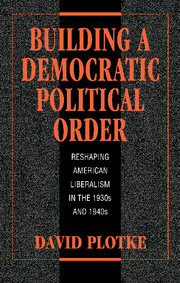Book contents
- Frontmatter
- Contents
- Preface
- Introduction: The Democratic order as a political project
- 1 When does politics change?
- 2 Creating political orders: the logic of the Democratic experience
- 3 Democratic opportunities in the crises of the 1930s
- 4 Passing the Wagner Act and building a new Democratic state
- 5 Party and movements in the Democratic upsurge, 1935–7
- 6 Progressive liberalism as pragmatic common sense
- 7 Surprising years: electing Truman and sustaining the Democratic order, 1947–9
- 8 Passing Taft-Hartley: what the losers won (and what the winners lost)
- 9 New political fronts? growth and civil rights in the 1940s
- 10 Democratic anti-Communism and the Cold War
- 11 From Truman to Kennedy: the reach and limits of Democratic power
- 12 Was the Democratic order democratic?
- Index
7 - Surprising years: electing Truman and sustaining the Democratic order, 1947–9
Published online by Cambridge University Press: 17 September 2009
- Frontmatter
- Contents
- Preface
- Introduction: The Democratic order as a political project
- 1 When does politics change?
- 2 Creating political orders: the logic of the Democratic experience
- 3 Democratic opportunities in the crises of the 1930s
- 4 Passing the Wagner Act and building a new Democratic state
- 5 Party and movements in the Democratic upsurge, 1935–7
- 6 Progressive liberalism as pragmatic common sense
- 7 Surprising years: electing Truman and sustaining the Democratic order, 1947–9
- 8 Passing Taft-Hartley: what the losers won (and what the winners lost)
- 9 New political fronts? growth and civil rights in the 1940s
- 10 Democratic anti-Communism and the Cold War
- 11 From Truman to Kennedy: the reach and limits of Democratic power
- 12 Was the Democratic order democratic?
- Index
Summary
If you wanted to compare it to the field of battle, let's say that President Roosevelt conducted a constant offensive for twelve years, and finally then he left and President Truman came in. I think President Truman found that maybe we had advanced to a point where it was not a good idea to advance further. Stop and establish a line at that point, bring up your supplies, bring up your lines of communications, reorganization, and reevaluate, and then gradually, and slowly, start a gradual new offensive under the name of the Fair Deal.
– Clark CliffordFrom 1947 through 1949 the Democratic order was sustained through the defense of position Clark Clifford described. Truman's presidential victory surprised many participants in the postwar political conflicts; few believed he would win and few presumed the Democratic order would continue. Yet the main story of American politics in the late 1940s was Democratic persistence, despite factional conflicts and conservative pressures. New reform accomplishments were limited, but the Democratic order was not overturned or fundamentally transformed.
The political conflicts of 1947 through 1949 could have led to the end of the Democratic order. Much of the Republican and conservative Democratic opposition sought this objective after the war. Yet no such end occurred.
- Type
- Chapter
- Information
- Building a Democratic Political OrderReshaping American Liberalism in the 1930s and 1940s, pp. 190 - 225Publisher: Cambridge University PressPrint publication year: 1996



